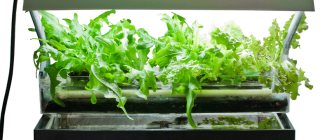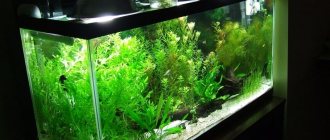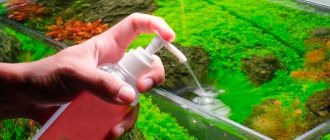- Effect of carbon dioxide on yield
- How to increase CO2 concentration?
- Open ground
- Closed ground
- How much CO2 should be supplied to plants and at what time?
Everyone knows from biology lessons how respiration processes occur in plants.
The human body is structured differently, which is why we coexist perfectly on our planet and depend on each other. Carbon dioxide is carbon dioxide, which in chemistry is represented by the formula CO2. It is an odorless and colorless gas, a small percentage of which is found in the air. It is the source of pure carbon for plants, which underlies all their life processes. CO2 plays a very important role in the process of photosynthesis, enabling the plant body to produce the energy necessary for growth and development. Without carbon dioxide, plants will simply die, like a person without oxygen.
Carbon dioxide generator for organizing plant photosynthesis in greenhouses
In hermetically sealed greenhouses, plants are provided with sufficient lighting, supplies of water and nutrients, but the pace of their development is limited by the level of CO2 in the indoor air.
Carbon dioxide is necessary for plants in chemical reactions (photosynthesis) for the biosynthesis of carbohydrates as the basis for the nutritional and skeletal components of plant cells and tissues in order to ensure growth and development. Gas exchange during plant respiration occurs through small, adjustable openings called stomata.
The stomata is found on either the upper or lower layer of the epidermis of a plant leaf.
In the earth's atmosphere, the level of carbon dioxide is 250÷450 ppm, and the need of various plant species is 700–800 ppm. In new greenhouse complexes with good sealing, the level of CO2 indoors is 4 times less than in the outdoor air, and this negatively affects the growth and development of crops.
Moreover, with an increase in the duration and power of artificial lighting in a room, the plants’ need for CO2 increases by 2-3 times. By saturating the greenhouse air with carbon dioxide, crop growth and productivity increase by 20–40%.
Did you know? Ruins of greenhouses dating back to 79 AD. e., were found during excavations in Pompeii. Modern greenhouses originated in the 13th century in Italy.
Preventing mash from entering the aquarium
The next device to use to prevent yeast from entering your aquarium is a mechanical gas separator. This is a water bottle with two fittings. The idea is to separate the gas from its solid or liquid components using gravity.
The diagram shows an example of a separator made from a 0.5 liter mineral water bottle. This bottle is attached with nylon ties to the two liter bottle of the generator. Two fittings are built into the plug. A tube long to the bottom of the bottle is attached to one fitting inside the bottle. This is the entrance to the separator.
The bottle is filled two-thirds with water. The concept of the separator is as follows: a mixture of gas, liquids and solid particles falls through a long inlet tube to the bottom of a bottle filled with water. Liquids and solids remain in the water, and gas rises through the water and goes towards the reactor. For best efficiency, the separator should be placed as close to the generator as possible so that the gas lines between the two vessels do not become clogged and stop your system.
Using these two devices will make your homemade system safe, reliable and highly efficient, and you will be free from problems associated with clogged gas pipes, this common problem with all homemade CO2 generation systems.
Scheme of CO2 supply in industrial greenhouses
The carbon dioxide supply system in commercial greenhouses includes a gas generator, fan, dosing device, gas analyzer and transport lines. Control is carried out using a computer.
Methods for obtaining CO2:
- technical CO2 from cylinders;
- methane combustion;
- waste gas from heating installations;
- waste gas from mini thermal power plants.
Boiler house exhaust gas
The most common method of greenhouse CO2 enrichment is the combustion of fossil fuels. The flue gases used should not contain dangerous amounts of harmful components, so most often the fuel for gas generators in greenhouses is methane. When 1 m³ of methane is burned, approximately 1.8 kg of CO2 is produced.
Important! Measuring devices - gas analyzers, which constantly monitor the composition of exhaust gases, allow you to maximize the safety of the room.
When combustion flue waste is used, the hot waste gases are captured and purified. After cleaning the exhaust gas by catalytic neutralization using catalysts or scrubbers, the gas-air mixture is cooled in a heat exchanger to 50°C and supplied through a gas pipeline to the greenhouse in the form of fertilizer.
However, this method of supplying gas to fertilize plants can lead to greenhouse air pollution with harmful impurities of combustion products, because gas cleaning devices purify gas waste by only 50–75%. Consequently, the concentration of harmful substances in a closed greenhouse may exceed the maximum permissible standards for plants and humans.
It is not possible to ensure continuous combustion of burners in heating boiler houses due to changing ambient temperatures, which is why the flow of waste gas is uneven. In addition, palladium catalysts and scrubbers are economically expensive and increase the cost of maintaining a greenhouse.
We recommend that you familiarize yourself with the features of heating greenhouses with gas in more detail.
Distribution networks made of polyethylene hoses
A transport line made of polyethylene pipes is used as a gas distribution system inside the greenhouse. At the gas sampling points above each bed, flexible polyethylene hoses with a diameter of 50 mm with evenly spaced holes are attached to it. The sleeves are equal to the length of the beds and are stretched along them or under the racks. The formation of condensate inside the system is eliminated by tilting the pipes.
CO2 is significantly heavier than air, so it is important that the gas is vented from below. Circulating air using horizontal fans or a trickle ventilation system ensures even distribution, moving large volumes of air throughout the greenhouse when overhead vents are closed or exhaust fans are not running.
Gas supply system and options for small farm or home greenhouses
For private and small farms, there are simpler and less expensive methods of gas supply, taking into account the area of greenhouses, the type and number of crops grown.
Did you know? The use of gas combustion products to increase the level of CO2 in the air of greenhouses was proposed back in 1936 based on successful experiments with vegetable crops by specialists from the Energy Institute and the Timiryazev Academy.
Gas generator
A gas generator for small spaces is based on obtaining the necessary carbon dioxide from atmospheric air. The productivity of such a device is 0.5 kg/h. The device is equipped with filters, which allows you to obtain purified gas, and dispensers ensure the supply of the required volumes. The microclimatic parameters of the greenhouse do not change.
Gas cylinders
Gas from cylinders is used for small areas at a pumping rate of 8–10 kg/h for every 100 m². The cylinder must be equipped with a pressure regulator (reducer) and an automatic valve to shut off the gas supply (solenoid) - these devices will secure the gas supply.
The capacity of 1 cylinder is 25 kg of gas. If costs are significant, it is more rational to use isothermal tanks of various capacities for liquefied gas, which can be replenished if necessary.
Gas sensor and regulator
Gas supply must be monitored and regulated to ensure optimal balance and good growing conditions, avoiding costly overdoses and ensuring the safety of people tending and harvesting crops.
To monitor and measure CO2 levels in a greenhouse, sensors with a set point setting such as 800 ppm are typically used. When the sensor detects a low level, it activates the dosing system. When the required CO2 level is reached, the control system will turn off the CO2 supply.
Sensors and regulators can trigger an alarm when the permissible concentration level is exceeded and turn on an emergency ventilation system. Currently popular on the market are IR CO2 sensors designed using the dual IR beam principle.
PVC hoses and pipes for CO2 supply
The issue of supplying gas to a room is not difficult, and everyone solves it independently. Typically, the distribution system consists of a main gas pipeline made of pipes (PVC or polypropylene), plastic perforated hoses of small diameter (50 mm) and connected sensors and a climate controller.
The gas flows directly to the plants through holes in the sleeves. The sleeves can be hung by a rope at any level - on beds to fertilize the root system, on racks and trellises for supply to leaves and growing points.
This makes it possible to accurately and economically dose gas of almost 100% concentration throughout the day to the desired growing area. Feed rates are regulated depending on climatic indicators and daily and seasonal dynamics of photosynthesis.
Biological sources
Check out
How to choose the best greenhouse Biological sources of carbon dioxide can be a harmless and affordable choice of gas supply.
If there are animals on the farm, then by placing the greenhouse across the wall from the barn and equipping both rooms with supply and exhaust ventilation, you can organize the supply of carbon dioxide to the plants from the respiration of animals, which, in turn, will receive oxygen from the plants.
In this case, the balance and volumes of gases, as well as regulation, will have to be determined experimentally. The same method of CO2 delivery can be provided from breweries and distilleries.
Carbon dioxide for cucumbers from manure
Manure and other organic substances not only provide plants with nutrients, but also release carbon dioxide during fermentation, the amount of which can improve the growth of vegetable crops. This creates favorable conditions for air nutrition of both the root system and the above-ground parts of the plants.
Manure should be diluted with water in a ratio of 1:3.
A clear example is the story that happened at the turn of the 19th and 20th centuries at the Timiryazev Academy, where for several years they tried to grow cucumbers in greenhouses, but, despite the scientific approach, they were not successful. Then the scientists decided to turn to Klin gardeners who grow enviable crops of cucumbers in their greenhouses.
They invited a gardener from Klin and offered to grow cucumbers for themselves in the academy’s greenhouse, but allow him to use his technology in the future. The trick was that containers with diluted manure were installed inside the room, and the carbon dioxide released during fermentation fertilized the cucumber plants.
It was experimentally established that with continuous fertilization with carbon dioxide during the daytime, the maximum (54%) increase in the weight of cucumbers is achieved.
We recommend that you familiarize yourself with: specialized equipment for greenhouses.
Alcoholic fermentation
Alcoholic fermentation, like microbiological decomposition, is a method of producing carbon dioxide. By placing cans with fermented wort among the plants, you can ensure that the air is saturated with carbon dioxide. For fermentation, water, sugar and yeast or carrion and unsuitable fruits and berries, grain (wheat, rye) are used.
Another way is to use nettle fermentation.
To do this, fill the container one third with grass (fresh or dried) and fill it with water. Fermentation lasts two weeks. The mixture is stirred daily to release CO2. To eliminate the unpleasant odor, you can add valerian (1-2 branches) to the mixture or sprinkle dust on top.
The fermented mixture is used as liquid bait. To regulate the supply, special caps (CO2Pro) are used, which are easily screwed onto standard plastic bottles.
Important! Fermentation odors can be reduced by placing the containers with the wort on a water seal, as is done when making wine at home.
Drinking carbonated water as a source of carbon dioxide
A regular bottle of sparkling water is an affordable, albeit ineffective source of carbon dioxide. Approximately 6–8 g of carbon dioxide is dissolved in 1 liter of carbonated water, depending on the degree of carbonation.
The method does not allow you to accurately determine the gas concentration and calculate the optimal dosage, so it can be considered as an emergency measure to increase CO2 levels in small volumes of the room. Another way to use carbonated water as a fertilizer is to saturate water for irrigation from cylinders with carbon dioxide.
Natural sources of carbon dioxide: air and soil
If the greenhouse is not equipped with a CO2 supply system, then atmospheric air is a natural source of CO2 for plants with regular ventilation of the room and open transoms. But this provides only a third of the daily requirement.
Check out
How to make a polycarbonate window for a greenhouse with your own hands Night respiration of plants and soil decomposition processes, respiration of plant roots, bacteria, fungi and soil microorganisms also replenish the greenhouse with carbon dioxide.
Another low-tech method of adding CO2 is composting plant material and organic matter in a greenhouse , which leads not only to the enrichment of the soil with macro- and microelements, but also to the replenishment of CO2 (up to 20 kg/h per 1 ha).
The composting process produces carbon dioxide, but it also releases harmful gases and creates conditions for the proliferation of pathogens and insects. The concentration of CO2 generated by this method is difficult to control and the method is unreliable.
Do-it-yourself carbon dioxide supply system and generator for greenhouses: justified or not
The feasibility of manufacturing a gas generator should be assessed independently based on your financial and material capabilities and labor costs.
In addition to installing a gas generator in the form of a boiler with a large heat release, you will need a gas delivery system to the greenhouse premises (gas pipeline), measuring and control equipment. Thus, manufacturing the system yourself is possible, but its rationality for small greenhouse areas can only be assessed using mathematical calculations.
It is much easier and cheaper to study alternative sources of carbon dioxide and methods of using them in closed ground conditions. For example, a liquefied gas system costs about 2 million rubles, and if you use gas from cylinders, the cost is reduced by 10 times.
Important! High concentrations of carbon dioxide are toxic to living organisms, so increasing the level to 10,000 ppm (1%) or higher within a few hours will eliminate pests (whiteflies, spider mites) in the greenhouse.
Why is it needed?
In addition to fertilizing with mineral and organic fertilizers, regular watering and maintaining the required temperature, plants need carbon dioxide. Many farmers regard it as a fertilizer. Carbon dioxide takes an active part in photosynthesis. Therefore, many gardeners install a CO2 supply system in greenhouses. The presence of carbon dioxide in the greenhouse is vital for the plants to develop properly and produce a large harvest. Benefits of CO2:
- Promotes activation of early and most active flowering, increased fruiting;
- Takes part in the synthesis of dry matter by 94%;
- Helps increase plant resistance to diseases and pests.
Basic Submission Rules
The dosage and time periods for saturating greenhouse air with CO2 depend on the season and time of day, the degree of sealing of the room, the intensity of illumination and the type of crops grown.
Lighting
As a result of photosynthesis, plants obtain carbohydrates for growth and development by processing carbon dioxide and water using light energy. These 3 components are important for the mechanism of opening of stomata on the leaf surface and the beginning of gas exchange between plants and the external environment. Under intense light, plants consume CO2 more actively, and the rate of photosynthesis increases.
The indoor CO2 concentration should be maintained at 600–800 ppm. With intense lighting, the temperature in the greenhouse rises, and the transoms have to be opened for ventilation, so the concentration is increased to 1000–1500 ppm.
CO2 consumption under sunlight is about 250 kg/ha per daylight hours with the windows closed. With open windows and windy weather - 500–1000 kg/ha. In winter, gas fertilization rates are reduced to 600 ppm, as artificial light helps accelerate photosynthesis.
Submission time
CO2 supplementation is most effective when the plant is actively growing during the light period. CO2 generation should begin in the morning two hours after the start of illumination until the desired concentration level is reached (1 hour). The generator must then be turned off. CO2 levels will return to ambient levels before dark.
Important! Increased CO2 levels only occur in a hermetically sealed greenhouse, since infiltration of the outside atmosphere will dilute the indoor carbon dioxide concentration.
The second addition should be carried out 2 hours before the end of daylight and the plants enter a state of sleep - the resulting carbon dioxide will be effectively absorbed and processed at night.
Blend Guide
Yeast is the main component of your homemade CO2 generator. Regular baker's yeast is sufficient for CO2 generators. But the effectiveness of different varieties of yeast on different nutritional bases may differ.
It is important to understand that yeast, sugar and water mixtures are not an exact science. You must experiment to find the best formulations for your conditions.
Simple mixture formula
For a two-liter bottle:
- 2 cups water
- 2 cups cane sugar
- teaspoon dry yeast
- a cup of not very warm water (ideally around 40 °C)
First, the yeast is dissolved in a cup of warm water, then the whole mixture is mixed in a reactor.
This is the simplest mixture that can work for up to 16 days.
Improved mixture formula
- 1 cup water
- 2 cups sugar
- teaspoon wine yeast
This is a more expensive mixture. Liquid live yeast is used here. There is no need to dissolve them. This yeast is more tolerant of the alcohol level in the mixture and can last 22 days or more.
Notes on mixtures
You should experiment with your mixtures. Everyone's water is different, with its own unique chemistry. This significantly affects the performance of the mixture. Try changing the yeast/sugar/water ratios slightly until you find the one that works the longest.
It has been proven that a yeast mixture will work longer if you reduce the amount of yeast. Less yeast means you'll get less CO2 per minute, but it will be produced longer and more uniformly. More yeast means more CO2 production initially with a gradual decrease in productivity.
The aerobic phase does not produce alcohol. It would be possible to extend this phase, but to do this it would be necessary to introduce air into the generator chamber, blowing through the mixture. In this case, instead of CO2, its mixture with air would begin to flow into the aquarium, and CO2 in this case is much less soluble, which makes the aerobic system meaningless.











